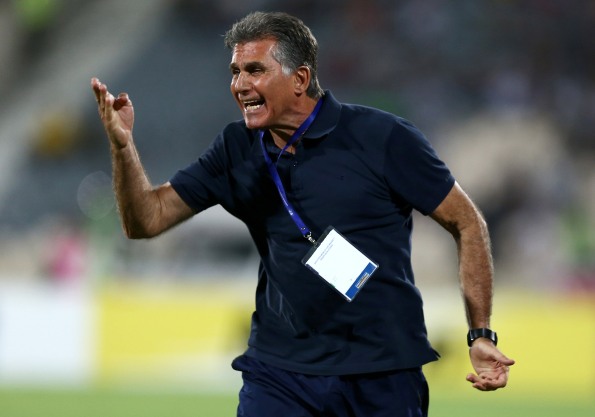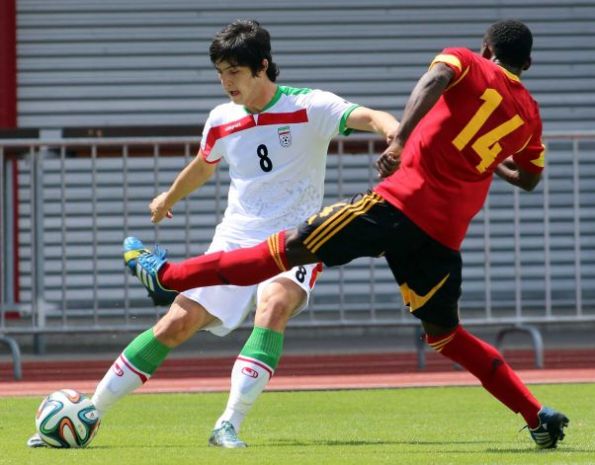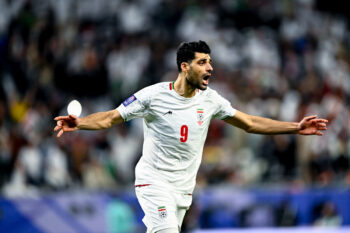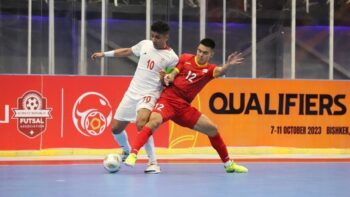Where’s Iranian football heading?

NOTBOTTOMLINE – TEHRAN, Iran’s national team, or Team Melli as it is widely known, held its own at the 2014 World Cup in Brazil and probably gained a few more neutral fans after their performance against Argentina. Despite going out at the group stage with a solitary point, there were momentary flashes which could have changed the outcome of Iran’s destiny.
Nevertheless, the general expectations, from the 75 million national team managers in Iran, had been one of hopeful optimism which would have had Iran on 4 points and scraping through to the second round.
Yesterday
Whilst Team Melli had historically seen itself as one of the leaders in Asian football, and subsequently felt an onus and expectation to attack the opposition whomever they may be (a style perfectly exhibited by teams of the 1970s, as well as the 1996 Asian Cup side and the side that failed to qualify for the World Cup in 2002), the reality had been a stark contrast for a long time. Iran no longer instills the same fear in opponents as it did in the past and the gap between Team Melli and teams, such as the UAE, Uzbekistan, Jordan and Qatar among others, has never been closer. Despite one off results against the likes of Japan and Korea, one could argue the gap between the real pacesetters in Asian football and Iran has never been wider either.
Today
Carlos Quieroz, the Portuguese Team Melli manager, is a man who has been able to produce a whole that is larger than the sum of its parts since he took over the helm. He has developed a mentally robust, defensively compact, counter-attacking team that is at its best when up against stronger opponents. Having taken over a team that had been plagued with an inability to cut open teams and a permanent slow tempo style for many years, Queiroz, a rational man, was at the crossroads going into Iran’s final World Cup Qualifiers against Lebanon, Qatar and South Korea. That is when Iran’s fortunes changed, matched by a distinctively new, more pragmatic, style of football.
Team Melli currently features an aging squad, with a number of key players well past their prime. In fact, one could argue that the side has still not successfully replaced retired stalwarts like Ali Daei, Mehdi Mahdavikia, Ali Karimi, Karim Bagheri, and even the likes of Vahid Hashemian and Rahman Rezaei. Those players formed a strong backbone of the side for a longer period than they probably should have based on their age and the trend is now repeating with a current crop which includes captain Javad Nekounam, Jalal Hosseini, Pejman Montazeri, Andranik Teymourian and even Masoud Shojaei among others. During the recent friendly match at the Azadi Stadium against Korea, Iran’s starting line-up featured 6 players over 30, none of which should realistically expect to feature at the 2018 World Cup even if Iran progresses. In fact, other than goalkeeper Alireza Haghighi (26), utility player Ehsan Hajsafi (24), inside-forward Alireza Jahanbakhsh (21) and possibly Ashkan Dejagah (28) and Reza Ghoochannejad (27) no other member of the starting line-up should be able to make it to the World Cup in Russia other than via a tourist visa. Nevertheless, the over-30s are still forming the backbone of the national team in the short-term in order to keep the side competitive. In contrast, Korea had only called up 2 players, over the age of 30, into their squad for the match. Needless to say, without the aging players in question, it is unlikely that Team Melli would have qualified for the 2014 World Cup. Queiroz, a realist, is under pressure to deliver at least a semi-finals outing at the upcoming Asian Cup, and will utilize that spine to maximize the possibility. However, at what cost to longer term fortunes?
Professional Football a Double-edged Sword
The introduction of “professional” football in 2001 has not reaped the rewards towards the progress of football there. Salaries have been inflated and less players choose to move abroad, even if they may be technically good enough, due to the lifestyle that they are able to have domestically. At most, a few players move on short-term contracts to neighboring Gulf countries such as UAE and Qatar for a short and sweet pay-day. More and more average players make much more money than they would have dreamed of and automatically equate that to having “made” it. This hinders their progress up the footballing ladder. At the end of the day, despite all the success that provincial clubs have in Iran, the “Big Two”, Esteghlal and Persepolis, continue to lure their best players with inflated salaries. Those players rarely if ever continue on the same impressive path that they had been on with their previous clubs. There are exceptions to this trend and they include the likes of Haghighi, Sardar Azmoun, Jahanbakhsh and Saeed Ezatollahi among others who all took the risk to move abroad at a younger age than had been done by any Iranian footballers in the past. This has been a refreshing change and applauded by Quieroz too.
Domestically, the Iran Professional League (IPL) has remained competitive with only Sepahan able to retain the title since the league’s new format at the turn of the century. However, on a continental level, Iran has had 2 losing finalists during this period and no winners. In fact, the last Iranian club to triumph in Asia’s premier club competition was Pas Tehran but that was over 20 years ago at the end of the 1992/93 season. Iran has only had 3 champions at that level since the tournament’s inception in 1967. Korea, on 10, Japan, on 5 and Saudi Arabia, on 4, are all placed ahead of Iran in that respect. On the international level, Team Melli last won the Asian Cup in 1976 and has not appeared in the final since. Is it justified to really classify Iran as being among the strongest footballing nations at Asian level today?
Today Again
This brings us back full circle. Iranians are a demanding people and sometimes their expectations are further from reality than they would like to admit (or even realize). The commendable emergence of volleyball in the country has also cast another shadow over modern football. Iranian football has historically chosen the short-term solution over long-term planning. One could even argue that this may be a culturally-imprinted facet of being Iranian. Needless to say, Iran’s preparations for the recent World Cup was hampered by incompetence, from a federation and organization, point of view. Of course, in typical Iranian fashion, the blame was again deflected upon others, just as was the soap opera that was Queiroz’s contract extension thereafter.
Considering the parameters of existence within the football environment, how fair is it to request one man, Quieroz, to build a long-term legacy? Would football “people” in the country accept a first round elimination at the Asian Cup if it meant introducing an untested, younger generation, of footballers, who had many question marks hanging over their actual ability? Would Quieroz survive to remain at the helm and build a competitive squad for the 2018 World Cup in that scenario? The answer is probably no on both fronts and intense pressure and scrutiny does not help anyone formulate a long-term strategy for footballing development. In fact, its not clear whether Team Melli would be able to build a competitive squad that can qualify for the 2018 World Cup at any rate, regardless of the players it selects. It may be wiser to begin casting an eye towards the 2022 World Cup and possibly, as well as gracefully, concede a step back in the shorter-term. Considering Team Melli’s recent “successes” at Asian level as well as only qualifying for every other World Cup, it may not hamper its standing that much even in the short-term.
Results in the Asian Cup will not really matter unless Iran, surprisingly, at least to this writer, goes further than the Quarter Finals, as that would provide the side a bye towards qualifying for the next installment 4 years down the line. Going up against emerging teams such as the UAE and Qatar as well as Bahrain places Iran in it’s “kryptonite” situation. In the modern era, Team Melli has faced far more problems against Arab opponents, especially those from the Gulf, than sides from the rest of Asia. Expectation will be on Team Melli to attack all 3 opponents but that is not its strong-suit and could result in very close, and nerve-wracking matches that may be decided by a mistake or moment of brilliance, one way or the other.
When is Tomorrow?
For decades, Iranian football had been blessed by technically gifted players, who were arguably superior in that respect to most of their counterparts at Asian level. This carried Iranian football for a long time at the expense of tactical, mental and coaching development (as well as many other off-the-pitch developments). However, the conveyor belt for talent stopped producing such players a long time ago. Masoud Shojaei is probably the last truly gifted technical Iranian player to emerge and he is now the wrong side of 30.
However, the time is now for giving more responsibility to emerging future stars Azmoun and Jahanbakhsh, both arguably good enough to start regularly for Team Melli, as well as maybe begin the slow introduction of Atletico Madrid youngster Ezatollahi. It may also be wise to give a real opportunity to players such as Soroush Rafeei (24), Vourya Ghafouri (27) and Omid Ebrahimi (27), all second half subs against Korea, to figure out whether they can step up to international level. Bigger questions exist over which players can emerge to replace both center backs, Hosseini and Montazeri, sooner rather than later, as well as the central midfield duo, Nekounam and, a seemingly out of shape and out of form, Andranik Teymourian, for so long a model of dedication and professionalism in Iranian football. The answers to these questions do not currently exist. Iran’s U-17 team last qualified for the 2013 World Cup, when it progressed to the second round. That squad was more or less elevated to the U-19 Asian age group but failed miserably to qualify for next year’s U-20 World Cup after a disappointing first-round elimination in Myanmar earlier this year. Nevertheless, it is worth keeping an eye on Gholizadeh, Hazami and Moharrami from that batch.
The truth is despite the popular belief, by many, that Iranian football is currently in transition, the process has not really started. Team Melli has pushed back its expiry date for longer than most people could have imagined through the assistance, to a certain degree, of Carlos Quieroz. However, this has delayed the inevitable and painful process of transition, which sides such as Saudi Arabia have been experiencing for almost a decade, and others such as Australia have done a slightly better job of in the last couple of years. It always helps when you have potentially good replacements to step into the older players shoes but that is not looking like it will be the case with Team Melli. The road ahead may be a rude awakening for many followers of the national team.
Written by Babak Golriz
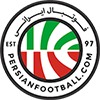

 (9 votes, average: 4.67 out of 5)
(9 votes, average: 4.67 out of 5)